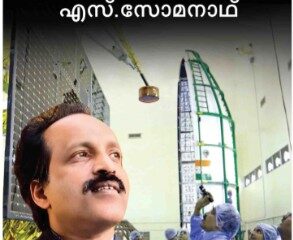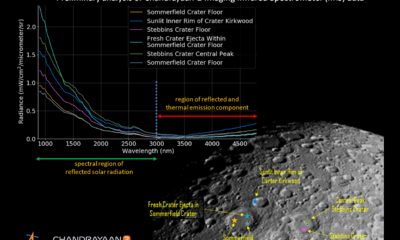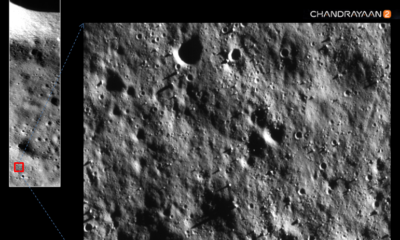Science
Working hard to reinstate communication with Vikram Lander, tweets ISRO

ISRO is making all efforts to reestablish contact with the Vikram Lander after the last minute Chandrayaan 2 debacle. The Indian space agency took to Twitter and revealed that the scientists are working hard to establish contact with the lander.
ISRO took to Twitter and disclosed that VikramLander has been located by the orbiter of Chandrayaan 2 but they are unable to establish any connectivity. Moreover, the tweet also included the information that the agency is making all possible efforts to establish communication with the lander.
#VikramLander has been located by the orbiter of #Chandrayaan2, but no communication with it yet.
All possible efforts are being made to establish communication with lander.#ISRO— ISRO (@isro) September 10, 2019
The Vikram lander is part of the Chandrayaan 2 mission. The Pragyan rover is embedded inside the lander. The lander has reportedly landed on the moon but ISRO is unable to establish contact. The whole mission went on pre-planned without any glitches except the final descent on the early Saturday morning.
Time is limited with ISRO because they have only 11 days remaining to establish connectivity with the Vikram Lander. The overall mission life of the lander is around 14 days, which is equivalent to one lunar day.
Even if the Vikram Lander managed to touch the moon successfully, the lander would have gone out of life after 14 days. However, the engineers would have got a wonderful chance to test the surface of the moon including the presence of water and other experiments.
The Vikram Lander has successfully followed the scheduled descent trajectory from its orbit of 35 km to below 2 km above the surface of the moon. The trajectory showed a slight deviation when the lander started to descent. However, the problem got rectified but the deviation was noticeable around 4 km range and after that, the lander instrument probably fell down on the moon.
According to an ISRO official, who refused to reveal the identity added that the Vikram Lander is on the moon as a single piece but in titled position. Hence, the mission control center is unable to establish communication.
To recall, ISRO chairman K. Sivan had in August 2019 disclosed that the final 15 minutes in the most terrifying part of the mission. He was afraid of the final 15 minutes since it requires a series of operations including the controlling the speed.
There are reports that Vikram Lander fell down on the moon at the same speed and the on-board computer was unable to rectify the anomaly. The descent required reduction of the speed and we hope that the lander was unable to adjust the speed.
The Vikram Sarabhai founded agency said that the mission has completed 95 percent of the objectives since the Orbiter is still circling around the lunar surface. The Orbiter has got a shelf life of 7.5 years since the Chandrayaan 2 launch was as per the textbook precision.
I am taking my blog to the next level with blogchatter’s #MyFriendAlexa
Science
ISRO releases first illuminated image captured by Chandrayaan-2 Imaging Infrared Spectrometer
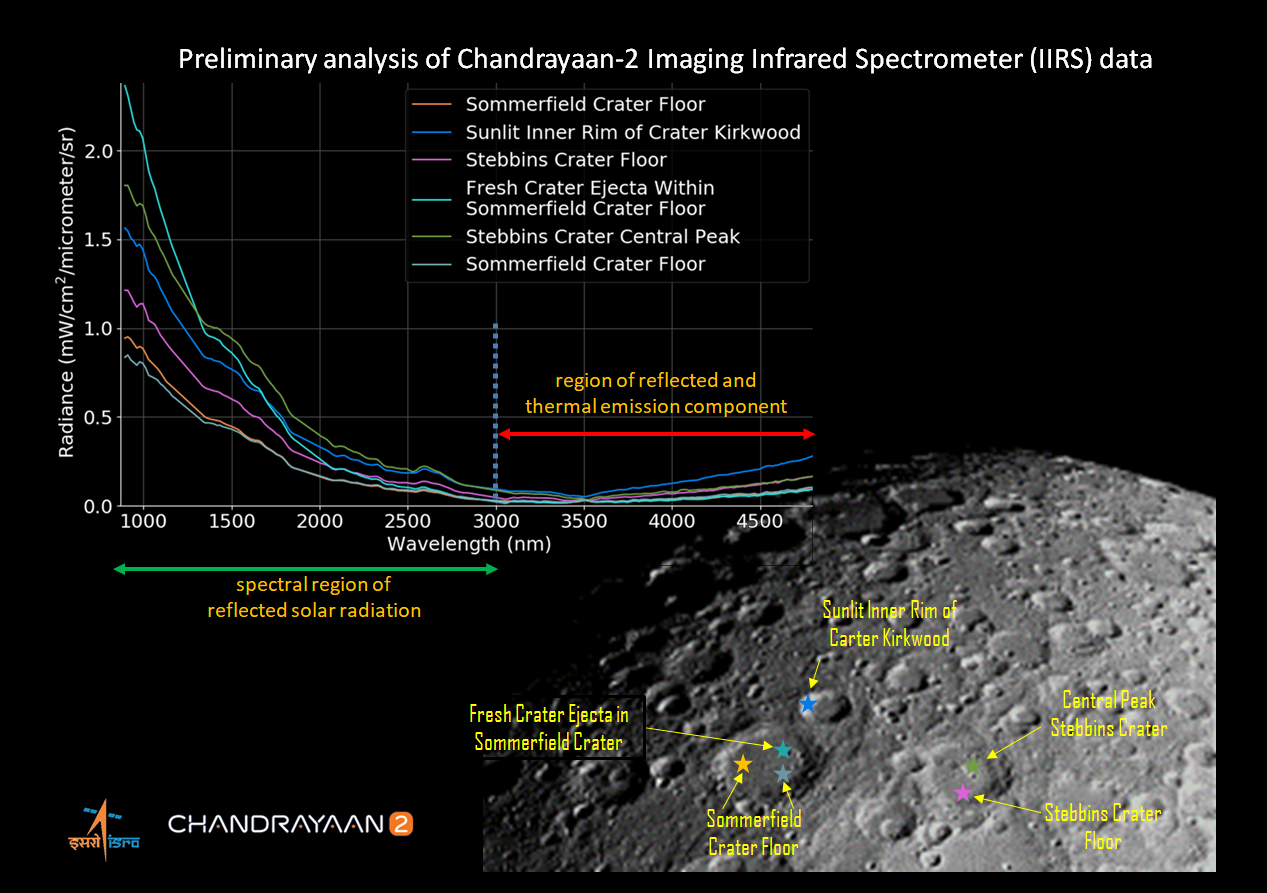
The Imaging Infrared Spectrometer (IIRS) integrated with the Chandrayaan-2 is designed to measure the reflected sunlight. The IIRS is designed to emit part of Moonlight from the lunar surface in narrow including contiguous spectral channels (bands) ranging from ~800 – 5000 nanometer (0.8-5.0 micrometer (µm)).
The Imaging Infrared Spectrometer makes use of grating to split and disperse the reflected sunlight (and emitted component) into different spectral bands. The main purpose of the IIRS is to understand the origin and evolution of the Moon in a geologic context by mapping the lunar surface mineral alongside volatile composition using signatures in the reflected solar spectrum.
ISRO has released the first illuminated image of the lunar surface as captured by the IIRS. The image shows part of the lunar farside in the northern hemisphere. You will be able to view few prominent craters such as (Sommerfield, Stebbins, and Kirkwood from the image released by the ISRO.
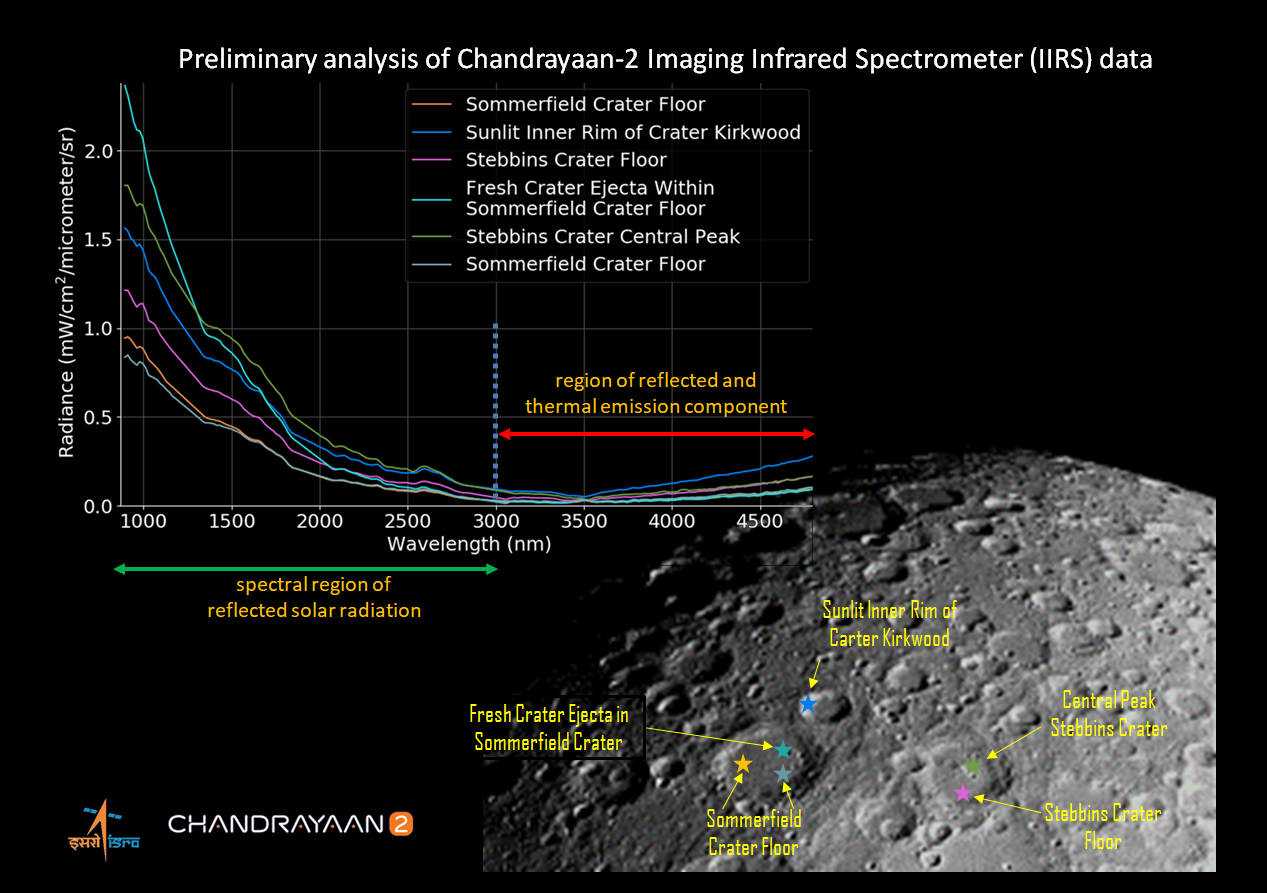
According to reports, the IIRS could successfully measure the variations in the reflected solar radiation that bounces off the lunar surface from different kinds of surface types such as crater central peaks, crater floors. The IIRS could also view fresh reworked ejecta associated with small craterlets within the crater floor of a large crater in addition to the sun-illuminated inner rims of craters.
The variations in the spectral radiance are primarily due to the mineralogical and compositional variations that exist in the lunar surface. It is also due to the effect of space weathering.
Science
ISRO Releases Chandrayaan 2 Orbiter High Resolution Camera Images

ISRO has released the images captured by the Orbiter High Resolution Camera (OHRC) included with the Chandrayaan2’s Orbiter. According to ISRO sources, the camera offers the highest megapixel ever launched any moon mission. The images expose the surface of the moon with craters.
#ISRO
Have a look at the images taken by #Chandrayaan2‘s Orbiter High Resolution Camera (OHRC).
For more images please visit https://t.co/YBjRO1kTcL pic.twitter.com/K4INnWKbaM— ISRO (@isro) October 4, 2019
The Orbiter High Resolution Camera (OHRC) bundled with Chandrayaan-2 provides very high spatial resolution images of the moon. The Orbiter operates in the visible Panchromatic band between 450nm to 800nm. The space agency will be able to capture the sharpest images with a spatial resolution of 25 cm from a 100 km orbit.
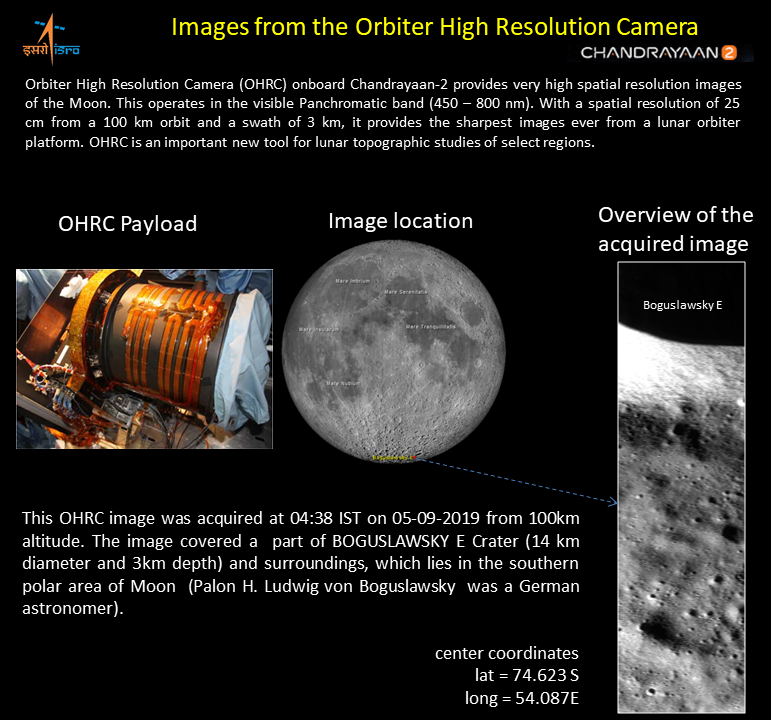
In a statement released to the press, the ISRo revealed that the OHRC images were acquired at 4.38 IST on September 5 from 100km altitude. The image covered a part of BOGUSLAWSKY E Crater and surroundings located in the southern polar area of the moon.
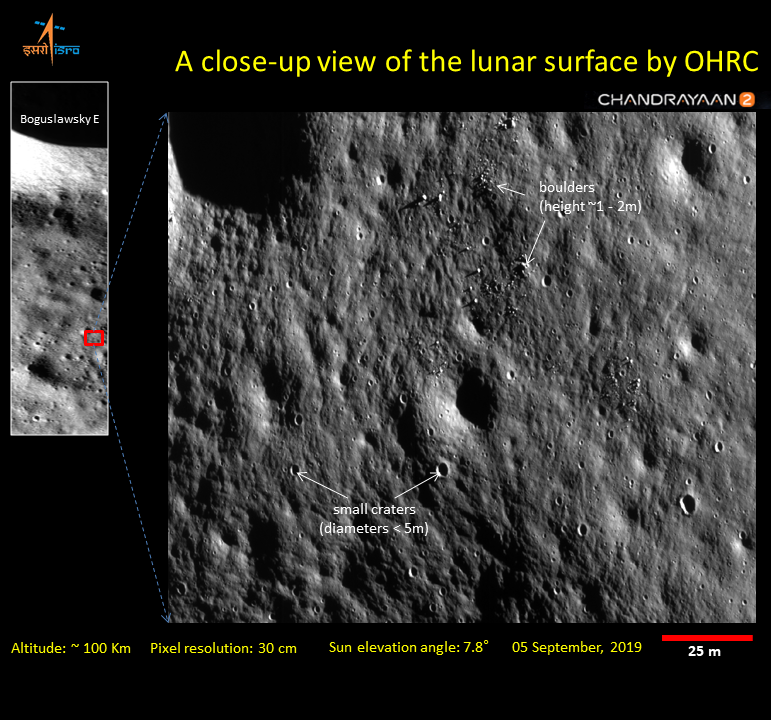
ISRO lifted off the prestigious Chandrayaan-2 moon mission with great expectations. The whole mission lasted over two months with several manovures. This includes separation of the orbiter with Vikram Lander. The Pragyan Rover was embedded inside the lander.
The whole Chandrayaan-2 mission was programmed in such a way that the rover enters the surface of the moon after the completion of the Vikram Lander touch down. If you follow ISRO launch missions, you will never forget September 7 because it is on this day that the lander was supposed to touch down on the moon.
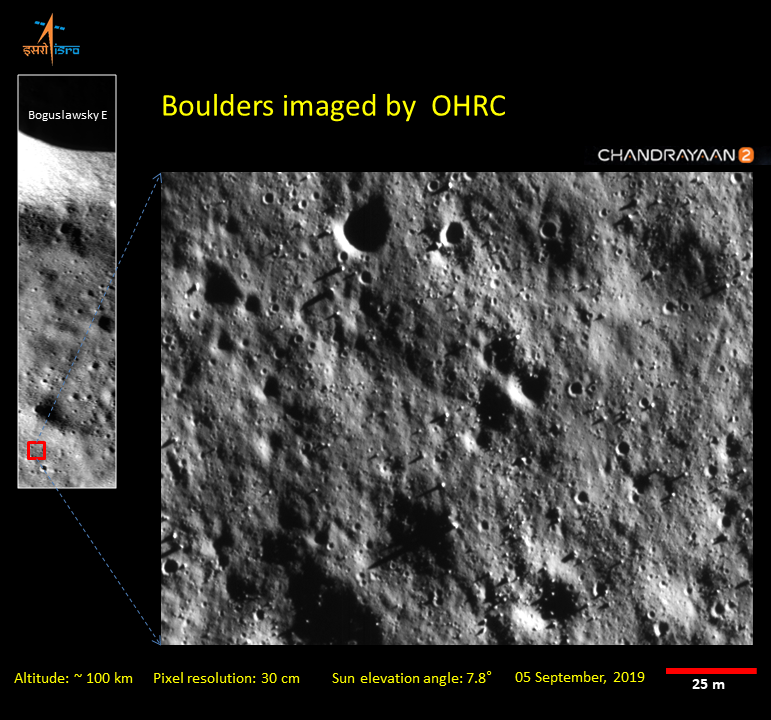
Prime Minister Narendra Modi was present at the mission control center to watch the golden moment. However, the expectations and happiness lasted only a few minutes because the lander disappeared just five minutes before the scheduled touchdown. Even though the whole mission was going as planned, the problem occurred during the descent stage when the lander reportedly lost control and fell on the surface of the moon.
ISRO had lost Vikram Lander and Paragtyan Rover embedded inside it. However, the orbiter bundled with the Chandrayaan-2 mission is still working perfectly. The interesting fact is that the Orbiter has got an overall lifespan of 7 years, which is sufficient to study the various factors on the moon.
Science
NASA confirms hard landing of Vikram Lander on the moon
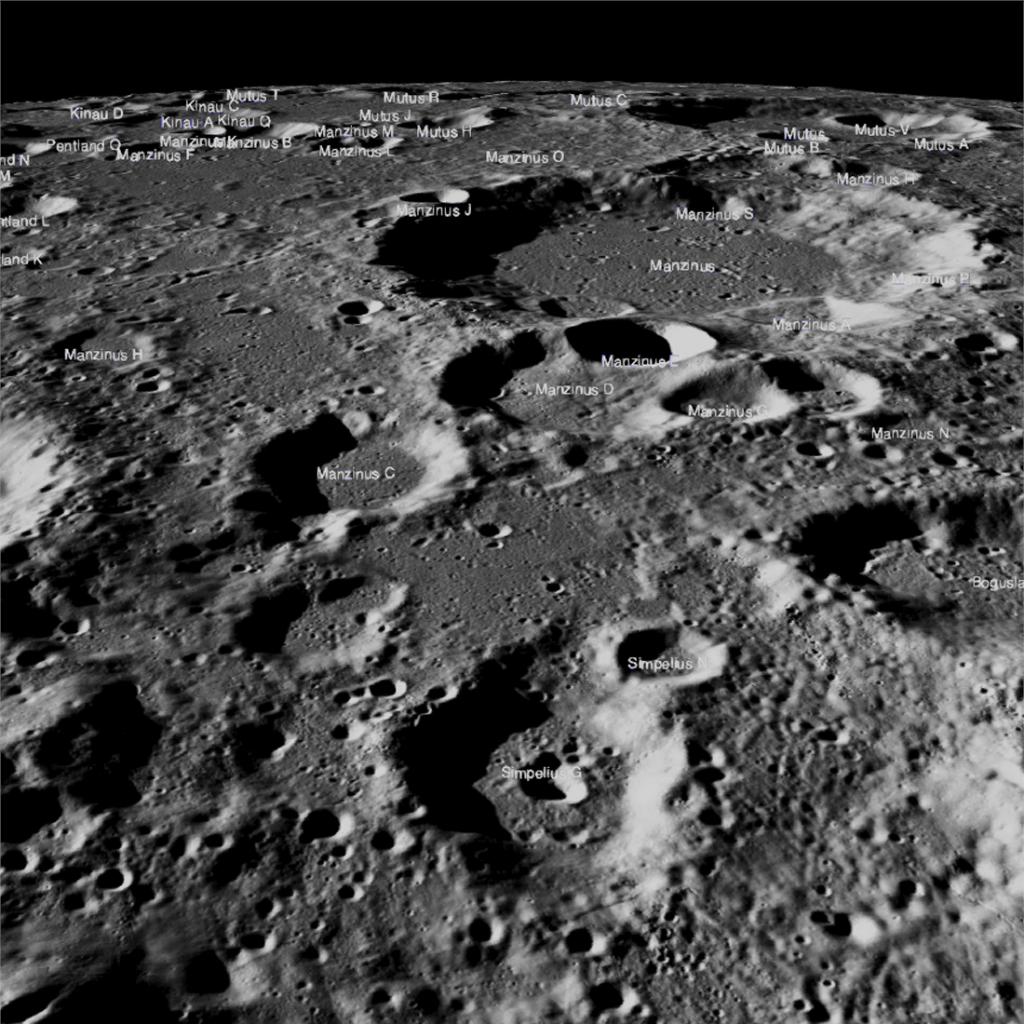
The fate of Vikram Lander, which was accompanied along with the ambitious Chandrayaan-2 is still in question. NASA took to Twitter and revealed that their orbiter failed to detect the lander on the surface of the moon. However, the US-based space agency managed to capture the site on the moon where the lander is supposed to soft land.
Our @LRO_NASA mission imaged the targeted landing site of India’s Chandrayaan-2 lander, Vikram. The images were taken at dusk, and the team was not able to locate the lander. More images will be taken in October during a flyby in favorable lighting. More: https://t.co/1bMVGRKslp pic.twitter.com/kqTp3GkwuM
— NASA (@NASA) September 26, 2019
The agency disclosed that the lander might be hidden deep inside the shadows since the images were captured at dusk. NASA also added that their Orbiter will capture more images during a flyby on the spot in favorable lighting.

The Orbiter is supposed to fly over the moon surface where the Vikram Lander was scheduled to soft land in good daylight. There are chances that the team could locate the lander next month.
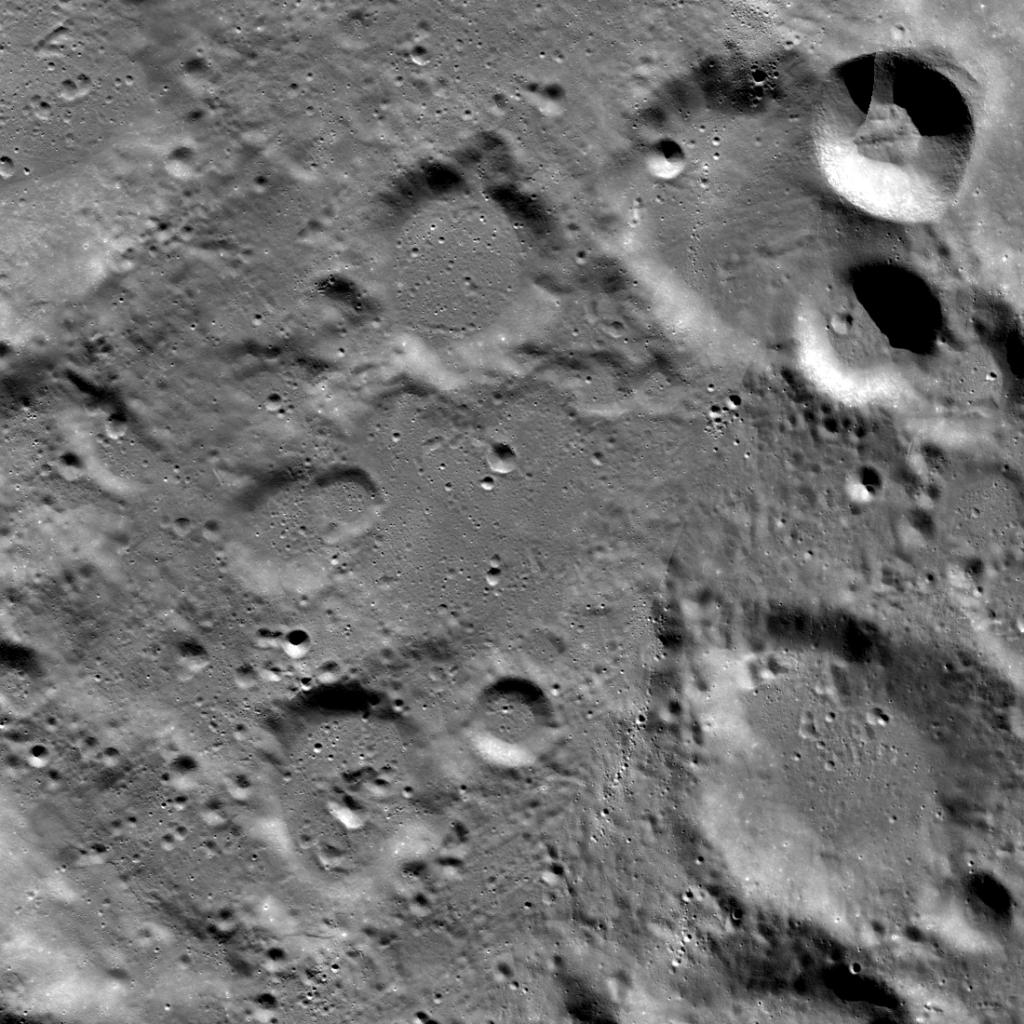
The images released by NASA show the surface of the moon in high resolution. If the Vikram Lander had landed as per the path and trajectory, we could be able to view the lander on the surface of the moon.
As you can observe from the above images, the lunar surface is full of rocks and craters. Hence, the lander could have faced extreme temperatures and crash landed somewhere away from the targeted location. ISRO has appointed a high-level committee consisting of senior officials and they will submit the report with the possible reason for the failure.
The Chandrayyan-2 mission went as planned without any problem. However, the mission control room lost connectivity with then lander when it was just 2 km above the lunar surface. The problem occurred around five minutes before the scheduled descent.
I am taking my blog to the next level with blogchatter’s #MyFriendAlexa
-

 Entertainment7 years ago
Entertainment7 years agoMalayam Actor Dileep Denied Bail In The Actress Assault Case
-

 Entertainment7 years ago
Entertainment7 years agoPuthiya Thalaimurai News Readers – Pictures
-

 Politics5 years ago
Politics5 years agoHowdyModi: Everything you want to know
-

 Entertainment7 years ago
Entertainment7 years agoAparna Balamurali Looks Beautiful In Sarvopari Palakkaran
-

 Entertainment7 years ago
Entertainment7 years agoVishu Celebrations – Suresh Gopi [Images]
-

 Entertainment7 years ago
Entertainment7 years agoHOT: Mollywood’s Most Romantic and Sensuous Lip-Lock Scenes
-

 Entertainment5 years ago
Entertainment5 years agoKaappaan Movie Reviews: Blockbluster or Flop
-

 Entertainment7 years ago
Entertainment7 years agoSaghavu – Madhumathiye Official Video Song – Nivin Pauly and Aishwarya Rajesh



